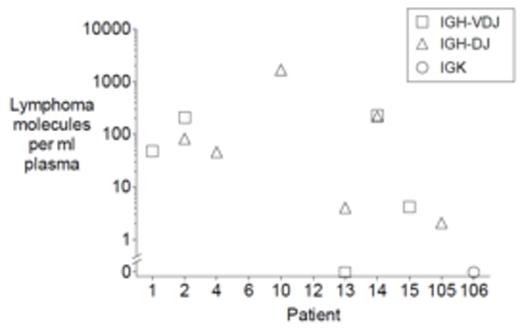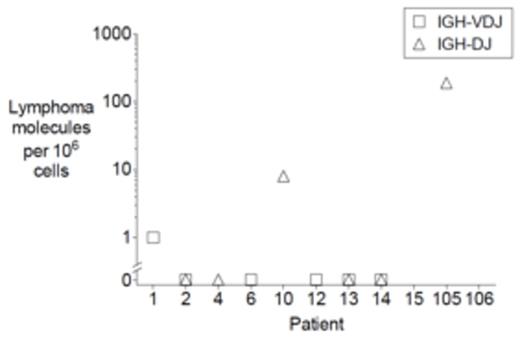Abstract
Background: Classical Hodgkin lymphoma (CHL) has been established as B-cell malignancy characterized by a clonal expansion of pathognomonic Reed Sternberg cells (Marafioti et al. Blood 2000). A previous report suggests that clonotypic B-cells may be present in the blood of patients with CHL; however, the relationship between these circulating clonotypic B-cells and CHL is unclear. We utilized the LymphoSIGHT™ method, a next-generation sequencing approach, to detect lymphoma-specific clonotypes in peripheral blood in patients with CHL at diagnosis or disease recurrence as well as in follow-up blood samples. This method has the sensitivity to detect one lymphoma cell per million leukocytes in peripheral blood, and has been applied to minimal residual disease (MRD) detection in multiple B-cell malignancies. We evaluated the extent of somatic hypermutation in the lymphoma clonotypes, and performed sequence and expression level analyses of the lymphoma clonotype repertoire.
Methods: Frozen primary tumor biopsy samples were first analyzed for clonality at the immunoglobulin heavy chain (IGH) and kappa chain (IGK) loci using the LymphoSIGHT method. Rearranged immunoglobulin gene segments (IGH-VDJ, IGH-DJ and IGK) in the genomic DNA and/or RNA were amplified with locus-specific primer sets, sequenced, and analyzed using standardized algorithms for clonotype determination. Clonotypes with a frequency >5% in the B-cell repertoire of the tumor biopsy were considered to represent tumor clonotypes. IGH-VDJ clonotypes with a frequency >2% in DNA were deemed to be cancer-specific if the clonotype was not present in the RNA. Such clonotypes were then quantitated in serum and peripheral blood mononuclear cells (PBMC), and DNA sequence and/or RNA expression level analysis was performed.
Results: A total of 17 CHL patients were analyzed. A high-frequency clonal rearrangement was identified for at least one receptor (IGH-VDJ, IGH-DJ and IGK) in 12 of 17 cases (71%). Lymphoma-specific clonotypes were detected in blood samples from 8 of 11 patients (73%). Notably, a lymphoma-specific clonotype was detected in the serum compartment in 8 of 9 cases (89%) tested (Figure 1A), while it was detected in PBMC only in 3 of 9 cases (33%) tested (Figure 1B). Follow-up samples obtained from three patients in remission were negative for the tumor-specific clonotype in both the serum and cellular compartments. We conducted sequence and expression level analysis of each IGH-VDJ clonal rearrangement. We calculated the number of somatic mutations in each lymphoma-specific clonotype compared to the germline sequence in the interrogated region. In the ten patients with IGH-VDJ clonal rearrangements, we observed a median of 14 somatic mutations (range 0 to 27). This confirms that HRS cells correspond in their developmental stage to germinal or post-germinal center B-cells. While IGH-VDJ clonotypes were observed frequently in DNA obtained at diagnosis, IGH-VDJ clonotypes were not detected in the RNA from the same sample. We evaluated the relationship between the presence of lymphoma-specific clonotypes in the cellular compartment at diagnosis and eventual progression. All three untreated patients that were positive at baseline in the cellular compartment experienced relapse or progression (at 3, 11 and 17 months). In contrast, zero of 5 patients without detectable lymphoma-specific clonotypes in their cellular compartment at baseline experienced relapse (follow up duration 23-45 months, log-rank test p=0.004).
Conclusions: This is the first clinical assay that can be used to detect and monitor MRD in CHL. Lymphoma-specific sequences can be identified in serum in 80% of cases. Our preliminary analysis suggests that the presence of lymphoma-specific clonotypes in PBMCs may indicate high risk for recurrence. This study demonstrates proof-of-principle and underscores the promise of a new methodology to measure disease burden and provide prognostic information from a blood test in patients with CHL.
Lymphoma clonotype levels in A) cell-free plasma and B) PBMC samples are shown for the different patients.
Lymphoma clonotype levels in A) cell-free plasma and B) PBMC samples are shown for the different patients.
Klinger:Sequenta, Inc.: Employment, Equity Ownership. Carlton:Sequenta, Inc.: Employment, Equity Ownership. Kong:Sequenta, Inc.: Employment, Equity Ownership. Faham:Sequenta, Inc.: Employment, Equity Ownership, Membership on an entity's Board of Directors or advisory committees.
Author notes
Asterisk with author names denotes non-ASH members.



